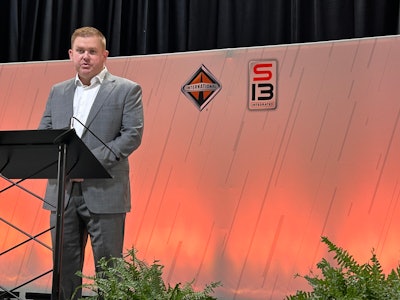 Brandon Tucker, director of operations of the Huntsville Powertrain Plant, cuts the ribbon Wednesday at the plant that will build the S13 powertrain.
Brandon Tucker, director of operations of the Huntsville Powertrain Plant, cuts the ribbon Wednesday at the plant that will build the S13 powertrain.
The company in February 2020 broke ground on a 110,000 sq. ft. expansion. The now-410,000-sq.-ft. facility has fully transitioned from a single assembly line to two (one for the T14 transmission and one for the S13 engine), along with the incorporation of three major machining lines. To date, more than 1 million engines have been built in Huntsville since the plant opened in 2008.
 Brandon Tucker, director of operations of the Huntsville Powertrain Plant, was joined by executives from Navistar and parent-company TRATON in Huntsville in commemoration of Wednesday's ribbon cutting.
Brandon Tucker, director of operations of the Huntsville Powertrain Plant, was joined by executives from Navistar and parent-company TRATON in Huntsville in commemoration of Wednesday's ribbon cutting.
The Huntsville plant employs more than 230 workers in the area. The 2020 expansion added roughly 100 jobs to the plant and the first commercial production S13 units rolled down the line in North Alabama last month.
In addition to the new assembly and machining lines, sustainability improvements were made to the plant; improvements that include LED lighting, a wastewater evaporator to minimize wastewater discharge, and new augers to separate recyclables from refuse to reduce landfill waste.
Manufacturing process improvements were also installed – like robotic assembly cells, enterprise connected manufacturing devices with advanced error proofing, and automated guided vehicles that allow the plant flexibility when needed.
"Today is a very special day," said Brandon Tucker, director of operations of the Huntsville Powertrain Plant, noting that executives from across Navistar and parent-company TRATON converged on Huntsville in commemoration of Wednesday's ribbon cutting. "I cannot wait for the bright future that we have in store for us, this city and our customers."
What is the S13 Integrated Powertrain?
The International S13 Integrated Powertrain is composed of the S13 engine, T14 transmission, and dual-stage aftertreatment system. It will be the final combustion product platform that Navistar will develop as the company transitions to zero-emission commercial vehicles.
"Navistar's goal is to achieve 50% zero-emission vehicle sales by 2030, and here we sit today celebrating an ICE machine," said Navistar Executive Vice President of Production and Logistics Stefan Palmgren. "I normally say this powertrain – the greatest we have ever seen – is, for Navistar and our customers, the bridge needed in the journey to 100% zero emission vehicles."
Introduced in 2022, the in-house designed and engineered S13 Integrated Powertrain was the first new International on-highway product since regulators approved Volkswagen subsidiary Traton Group's takeover of Navistar in 2021.
"This started almost seven years ago [in Sweden, with Scania]," Ryan Ludera, Navistar's S13 program manager, said of the birth of the S13 powertrain, "two very established brands that work in their own market and know what their customers' needs are. This product is a global platform... [but] tailored to North American needs."
The heart of the new powertrain is the 13-liter International S13 engine and its seven engine rating options, offering up to 515 horsepower and 1,850 lb-ft of torque. Built from the 12.7-liter displacement Scania Super, the low-rev, high-torque setup of the S13 engine allows for fewer fuel injections and lower fuel consumption – to the tune of about a 15% improvement in efficiency, Ludera said.
"This is the most efficient internal combustion engine that we've ever built," he said.
The S13 engine doesn't have an EGR cooler (selective catalytic reduction is the primary means of emissions reduction) and flows 100% of the exhaust to the fixed geometry turbocharger – a process that ensures a more complete fuel burn and allows cleaner air to enter the combustion chamber on the intake cycle to mitigate soot buildup while increasing power. The loss of a variable geometry turbo and EGR cooler eliminates about $6,000 in potential repair, according to the company.
The elimination of the EGR cooler from the combustion process also reduces the amount of soot and particulate matter, and the cleaner combustion cycle allows for extended service intervals while also eliminating the need for an active regeneration cycle and the diesel oxidation catalyst.
Behind the new 13-liter diesel is the International T14 – a 14-speed fully automated manual transmission and the first commercial transmission offered by International. The new gearbox is fully automated and was not adopted from an existing manual transmission. The T14 features a planetary gear set that supports a compact design and optional programmable reverse speeds. This transmission has two crawler gears for improved heavy load startability and low-speed maneuvering. Complete with deep low-end gearing and shifting smoothness, the T14 delivers efficiencies of a direct drive in an overdrive package.
As part of the clean sheet design, shifting logic and integrated software controls maximize efficiency and performance, resulting in gear shifting that is synched to engine revolutions.














